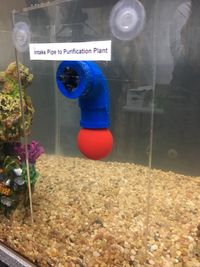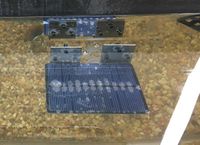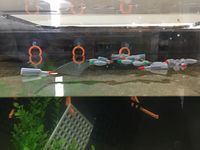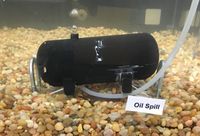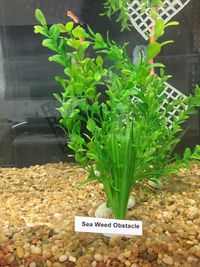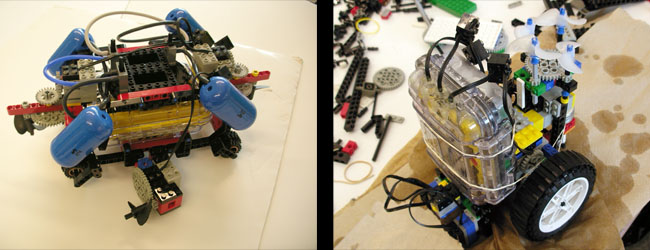Autonomous Underwater Vehicle (AUV)
Request for Proposal: Autonomous Underwater Vehicle (AUV)
This project reflects real life scenarios; the robot must be able to handle minor imperfections in the course.
Note: You should only use the materials contained in the price list for LEGO parts for robot projects. If you want to use other parts, get permission from your faculty member to do so, and also to determine the cost of the parts you want to use that are not in this price list.
Introduction and Overview
Australia Great Barrier Reef is one of the largest reefs in the world and the only living one that can be seen from space. This reef contains a massive collection of coral and underwater species making it an expansive ecosystem. Though due to rising water pollution and global warming the in the past few decades the Great Barrier Reef has lost over half its coral population, dangerous coral bleaching is damaging the ecosystem, and many species are at risk.
The Great Barrier Reef Marine Park Authority (GBRMPA) has begun funding research and innovative technology that can help assist in cleaning up the nearby ocean waters and improve the overall health of the local ecosystem. GBRMPA has given funding to your team of researchers and scientists to develop an autonomous underwater vehicle (AUV) that can handle the pollution in the area. This device should focus on being innovative and cost-effective.
Specifications
- Design a robot using Lego Digital Designer as your primary design tool.
- Build a model of your design using the materials provided.
- Design a Mindstorms program that will direct the robot's movements.
- Create a cost estimate of the robot's components.
- All revisions to the original design must be recorded and explained this includes technical design drawings, as well as cost estimates.
- All revisions to the Mindstorms program must be recorded and explained.
The AUV must be able to navigate autonomously around the test tank. The robot must achieve at least 100 points in 5 minutes. The tasks may be selected from the list of tasks below.If additional tasks are completed AFTER receiving 100 points for commissioning extra credit will be awarded.
The finished AUV must be less than a 1 foot by 1 foot by 1 foot. Any other components that the AUV uses, such as a tether, must also fit in the same box with the AUV.
The AUV must start in the starting area, but at any depth, facing any direction. The AUV may not touch any of the modules from the starting position.
These specifications must be met for final commissioning. Please refer to the course syllabus for all due dates.
AUV Field
Tasks across the tank represent different areas of pollution and disaster that oceans are currently facing. The picture above illustrates each task and the point value associated with accomplishing the task, and the table below provides more information. Task numbers correspond to the location numbers on this map. Point values are also noted.
AUV Tasks
| 1 | Lost Fish Nets — Fishing companies have lost some nets in the ocean, these lost nets get caught in and on local wildlife, this can result in wildlife getting stuck and dying in them. Find as many of the nets as possible. Knocking the nets off the holders will count for 5 points each bring them back into the starting base for an additional 15 points each (60 points max) | |
|---|---|---|
| 2 | Clogged Inlet Pipe — For most cities water comes from purifying local water supplies at water treatment plants, where an inlet pipe is located in the water to pump the water supply to the plant to begin treatment. The inlet pipe for this reverse osmosis plant, where saltwater supplies are purified, has been clogged due to the overpopulation of the nearby ocean water. Remove the plastic that has gotten stuck in the pipe for 10 points | |
| 3 | Wave Power Device — Wave power generation technology is a type of hydroelectric device that uses the motion of the waves to move a turbine to generate electricity. One of these devices became unhinged and moved away from its station. Locate the power device and return it to its original location, a large metal platform on the ocean floor. As long as the device is moved above the station and placed anywhere along the platform, the task is considered complete. (15 points)
|
|
| 4 | Installing solar panels — Solar Panels can be made to float on top of the surface of the water to prevent evaporation of water resources and to not take up space on land. Install a solar panel at the location closer to the start for 15 points and install a solar panel at the farther location for 25 points, both panels can be installed. The solar panels can be attached to the metal part in any way, as long as they touch. The solar panel will be carried by the robot from the start and placed at the marked locations. (40 points max) | |
| 5 | Repair the coral reef — Coral grows on top of old coral but due to the oceans being bleached these groups of coral are dying out and new coral is having a more difficult time growing. One solution is to install 3D printed coral on the ocean floor made out of environmentally safe filament. A piece of coral is considered installed when it is within a 3 cm of one of the metal pieces located in the coral field. The coral will be carried by the robot from the start and placed at the marked locations. The coral can be placed from anywhere inside the boundaries to up to an inch outside the boundaries. (10 points per coral piece, maximum 30 points) | |
| 6 | Plastic Trash — Platic trash is lining the top of the ocean, each piece of plastic is worth 1 point for moving it to the start position or the end of the course, they are worth 2 points for containing it inside the robot or moving it into a 3D printed device. (1 point each to if moved to start, 2 points each for containing it) | |
| 7 | Oil Spill — There has been an oil spill due to a sunken ship. The oil spill is leaking out of a broken oil tank simulated with air bubbles. Your goal is to design a device that will prevent the spill (air bubbles) from being visible for three seconds. The device is still part of your dimension limitations. This task is worth 20 points. |
Other Course Features
| Ocean Obstacles — The ocean is filled with many things that can get in the way including plants on the ocean floor. |
Important
Only the specified waterproofed sensors may be used. The EV3 must be enclosed in the modified Pelican case at all times when testing. Tethered robots are allowed but the EV3 (inside the modified Pelican case) must be inside the fish tank and not touched by any person. A TA must check and approve your design before your first initial testing.
For tips on how to waterproof your vehicle click here.
The AUV robot may start in any location and depth in the starting zone, however the robot may not be touch any of the field objects during the initial start.
The robot program may not be altered or switched during any part of the mission. Likewise, the robot must be fully autonomous and therefore cannot be touched by any person during testing.
If at any point water is spilled onto the EV3, power down the EV3 and remove the battery pack or its batteries. DO NOT turn the EV3 on again. Contact a TA immediately and they will perform the necessary procedure to preserve the electronic device from damages.
For safety reasons the use of the AC adapter is strictly prohibited for the AUV project while in the room 573A. The AC adapter is connected directly to a 120V AC source that could lead to serious injury if contacted with water. Also only the specified waterproofed sensors and cases may be used in the test tank.
Please Note: Some areas of the AUV navigation field are smooth; other areas have obstructions. Any robot that intentionally damages the course, or deemed unsafe for the aquarium will not be allowed to be tested.
During the competition, the instructors or your TA will make all judgments as to the successful completion of tasks, and will have final say in what counts as completed.
Creativity and innovation are always rewarded. Original and unique designs will receive extra credit.
Project Schedule
A project schedule must be created in Google Sheets. Please refer to the template provided in your team Google Drive folder and our guide.
This schedule must include all tasks related to the project from the start of the project to Early or Final submission. The project schedule should include:
- Minimum of 20 tasks, excluding Milestones
- Milestones should be clearly indicated on the project plan (duration of zero days)
- Each task must include the person responsible for completing the task (resource names)
- Gantt chart must be displayed alongside the tasks list (fit onto one slide)
- Gantt chart must show a progress line
- Clearly state during the presentations whether the project is on-time, behind schedule, or ahead of schedule
- In milestone presentations, please present a “Project Status” slide, which should summarize key deadlines. You are not required to show your project schedule in these presentations
Drawings
All drawings and sketches should be made using LEGO Digital Designer (LDD). LDD can be installed for free from the LEGO website.
Using LDD, create four drawings of the robot: front, top, most detailed side, and a drawing of the gear train(s). Sensors, motors, and gears must be included in each drawing. If the robot does not use any gears, make sure to explicitly state that in your presentations.
Each revision of the design must be documented and all changes must be presented during Milestone presentations.
Model
You must build a scale model (1:1) of your design. The following materials will be provided:
- Mindstorms kit
- One EV3
- Waterproof Sensors
- Motors
- Waterproof Pelican case
The finished AUV must fit inside a 1' × 1' × 1' box. Any other components that the AUV uses, such as a tether, must also fit within this box.
***Additional weights (ballast) and flotation devices (Styrofoam, air tanks) are allowed, but must be provided by the student, all additional materials must be deemed acceptable by either the professor or the TA, if they are deemed unsafe for the devices or hazardous to the course, they must be immediately removed before any additional testing is permitted.
Additional materials can be supplied by your TA.
Cost Estimate
Once a robot design is complete, a cost estimate must be generated that specifies the cost of all the materials and labor required for the construction of the design. Tabulate this cost information clearly in an Excel spreadsheet, using the materials cost list provided. Help in calculating the cost is available by reviewing how to plan the schedule and calculate costs for a project. The costs for the parts can be found on the price list for LEGO parts for robot projects.
Note: You should only use the materials contained in the price list for LEGO parts for robot projects. If you want to use other parts, get permission from your faculty member to do so, and also to determine the cost of the parts you want to use that are not in this price list.
The cost estimate should include the following:
- Labor cost breakdown with hours and rates
- Consolidate low-cost pieces: axles, beams, bricks, bushings, connectors, gears, plates
- Itemize high-cost pieces: controllers (EV3 brick), sensors, motors
- No decimal places; this is an estimate after all. Round appropriately
- Total cost must be shown in the bottom right corner
Notebook/Project Journal
While working on your project, you are expected to keep a record of all work done, as well as future plans and goals. In order to complete a Benchmark assessment, you must submit your notebook in .pdf format to the EG1004 website, as well as show your notebook to the Open Lab TA completing your assessment. A guide to writing the notebook, as well as a basic overview of its expectations, can be found here.
AUV case is included in EV3 brick cost.
Milestones, Benchmarks, and Deliverables
As work is done on the project, three Milestone presentations will report on the project's progress. All of the items assigned in each phase of the project are called Benchmark deliverables. These deliverables often consist of a combination of written submissions, presentations, and demonstrations. Benchmark assessments evaluate the progress of the project.
Preliminary Design Investigation
The Preliminary Design Investigation (PDI) is extremely important, as it lays the groundwork for the project. It outlines the project idea, inspiration, and goals.
The PDI must include:
- Cover Page
- Project Overview
- Goals & Objectives
- Design & Approach
- Cost Estimate
- Project Schedule
- Relevant Pictures
An example PDI template can be found here. The PDI is due by Benchmark A. Do not forget to include the items listed above. Use this link to access the VEX PDI Rubric.
Milestone 1
See How To Give a Milestone Presentation for the format of a Milestone presentation.
Milestone 1 is a presentation of the PDI. It is important that it outlines the project goals and show that the project is realizable.
The Milestone 1 presentation must include:
- Company profile
- Company name
- Product name
- Company officer title(s)
- Mission statement
- Project objective
- What is the project about?
- What tasks is the company aiming to accomplish? (Benchmark A requirements)
- Overall design approach to complete objective
- Background information
- Why is the project happening?
- What does the audience need to know?
- Technical design description
- Preliminary conceptual drawing of robot design
- Rendered and digital sketches are acceptable, CAD not required
- What components will be used and why?
- Preliminary conceptual drawing of robot design
- Cost estimate
- Major components of design listed
- Miscellaneous category listed
- Projected labor listed
- Microsoft Project schedule
- Click here to access the guide on how to transfer a file
- Teamwork agreement summary
- Summary
- Overall assessment on current state of project
- Is the project on schedule? Is it on budget?
- Next steps and future tasks
Look Ahead: What tasks are planned between now and Milestone 2?
Benchmark Assessment A
Benchmarks evaluate the progress of the project. Benchmark A is due at the end of Model Shop Session II. There are penalties for not completing this on time. Refer to the EG1004 Grading Policy for more information.
To pass Benchmark A, the design must complete all of the following:
- Earn at least 25 points.
Milestone 2
See How To Give a Milestone Presentation for the format of a Milestone presentation.
Milestone 2 Deliverables:
- Presentation:
- Project description
- Design approach
- Design changes since Milestone 1
- Mission statement
- CAD drawings: top, front, most detailed side, isometric, gear train
- Mindstorms program
- Updated cost estimate (previous and current). What changes were made?
- Updated Microsoft Project schedule (previous and current). What changes were made?
- Progress update: current state of the project (time, budget, etc.)
Look Ahead: What tasks are planned between now and Milestone 3?
Benchmark Assessment B
Benchmark Assessment B is due at the end of Model Shop Session III. There are penalties for not completing this on time. Refer to the EG1004 Grading Policy for more information.
To pass, complete all of the following tasks:
- Earn at least 50 points.
Milestone 3
See How To Give a Milestone Presentation for the format of a Milestone presentation.
Milestone 3 Deliverables:
- Presentation:
- Project description
- Design approach
- Design changes since Milestone 2
- Mission statement
- CAD drawings: top, front, most detailed side, isometric, gear train
- Mindstorms program
- Updated cost estimate (previous and current). What changes were made?
- Updated Microsoft Project schedule (previous and current). What changes were made?
- Progress update: current state of the project (time, budget, etc.)
Look ahead: What tasks are planned between now and the completion of the project?
Commissioning
Projects must be commissioned before Submission. Refer to the syllabus for Submission deadlines. There are penalties for not completing this on time. Refer to the EG1004 Grading Policy for more information.
To pass, the design must complete all of the following:
- Earn at least 70 points.
Final Presentation
The Final Presentation will be a technical briefing, similar to the Milestones, but also serves as a sales presentation explaining why your company should be selected instead of the competition.
Your Final Presentation must include:
- Company profile
- Company name
- Employee profile, role(s), and qualifications
- Mission statement
- Problem statement
- Why is the project happening?
- What does the audience need to know?
- Project objective
- What is the purpose of your project?
- Who does your project help?
- What problem does your project solve?
- Project description
- Specify LEED certification
- Examples of LEED implementations in Revit
- Revit drawings
- All floor plan drawings
- Dimensions
- 1:240 scale
- Views of exterior of building: front elevation, side elevation, isometric elevation
- Dimensions
- Specify LEED certification
- Market and product viability
- Does your company have competitors?
- What makes your project unique?
- How does your design compare to competitors - cost, quality, features?
- Is the project versatile?
- What is the price of your project?
- Conclusion
- Reiterating project purpose
- Highlight project features
- Future goals of the company
- Why should your company be awarded this contract?
- Video pitch
- Price of project
- Walkthrough animation of building in Revit
- Embedded into Final Presentation
- Problem statement
- Solution overview
- Company description and qualifications
- Drawings
- Mindstorms program
- Cost estimate
- Microsoft Project schedule
- Video demonstration
- Why should the company be awarded this contract?
Submission
All SLDPs must be submitted online. Please visit this page for the link to the Project Submission form and each project’s individualized login information. To submit, login to the EG1004 website using this special login information. Submitting with an NYU account or any other account will generate an error. Components may be resubmitted at any time before the deadline. Please note that submission times are based on the most recent submission.
Please note the deliverables for this project are as follows. If any of the following items are omitted, there will be a penalty. Be sure to click "Submit" at the bottom of the form and allow sufficient time for uploading. The following list includes deliverable items that are required:
- Submission deliverables:
- Final presentation
- Cover page and table of contents
- Final Mindstorms program
- Initial sketch
- All the drawings of your design (initial through final)
- Video
- Final MS Project Schedule
- Final cost estimate
- Resume(s) (No fictitious resumes will be accepted.)
Late Submission
Late submission is not allowed. If a project does not Commission or receive Partial Commission by the deadline set forth in the syllabus, the project will not be allowed to submit and will receive a 0 for the project grade. To receive Partial Commissioning, two TAs must evaluate the project and determine its degree of completion according to the Commissioning requirements and the project will be given a grade accordingly. Please refer to the EG1004 Grading Policy for more information.
| ||||||||


